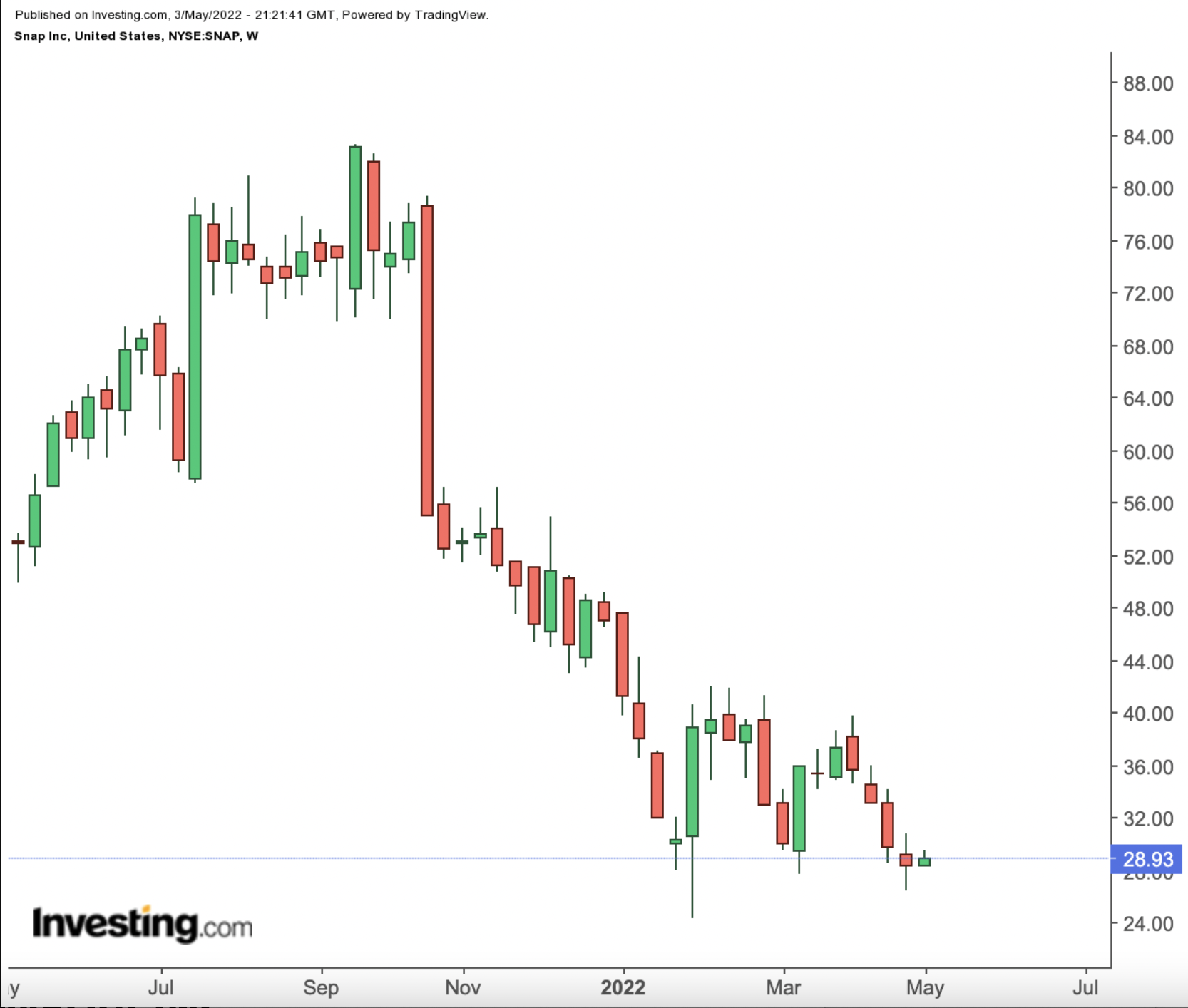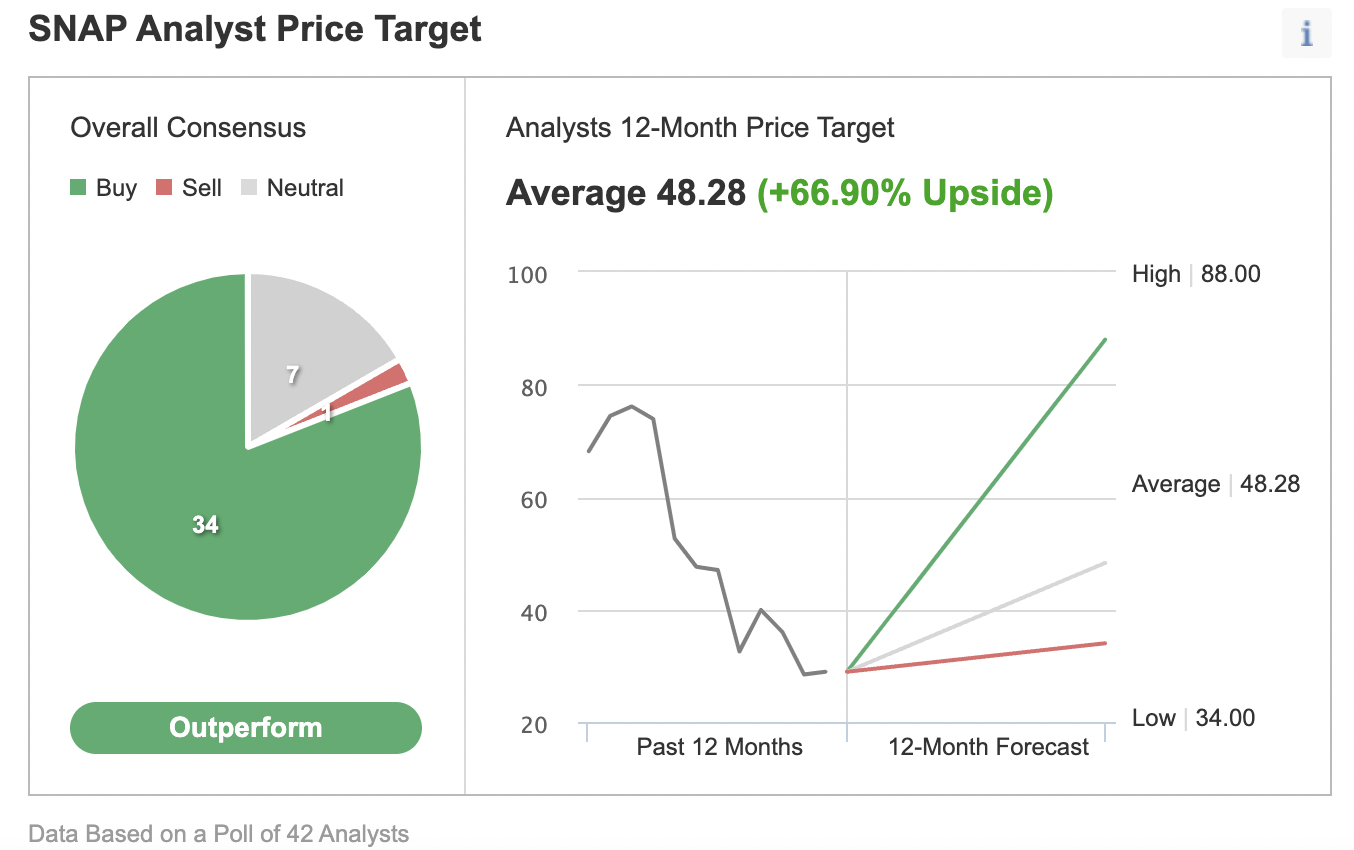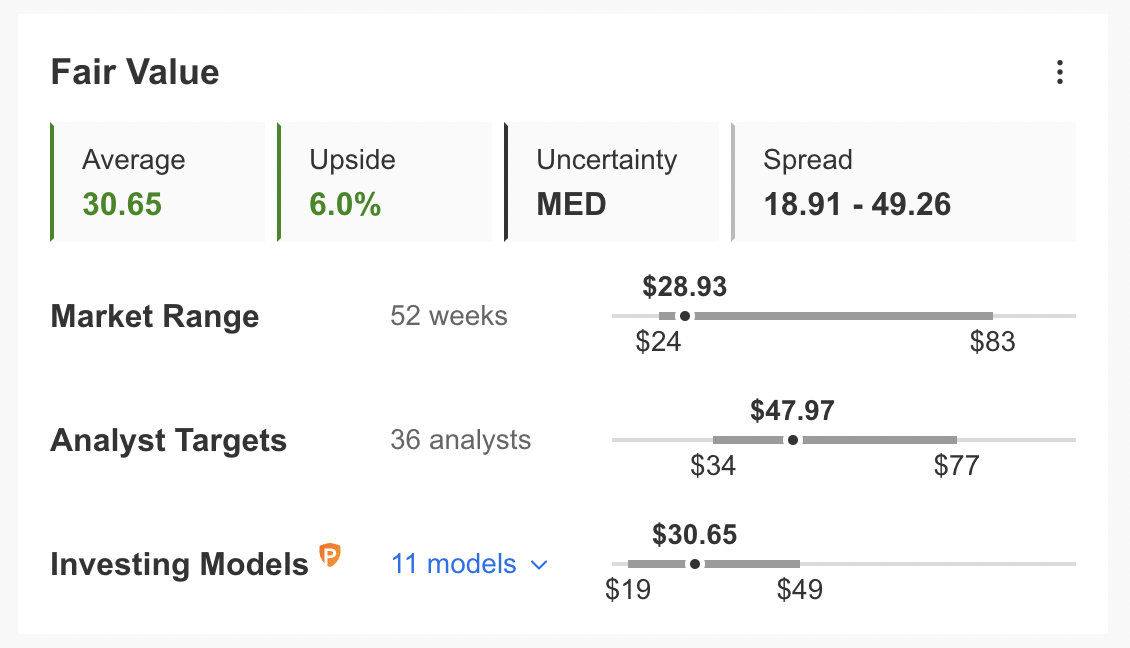- Snap shares have lost about 39% so far in 2022
- Recent metrics show a growing user base for the social media platform
- Despite current volatility, long-term investors could consider buying the stock at current levels
- If you’re interested in upgrading your search for new investing ideas, check out InvestingPro+
Shares of the social media stock Snap (NYSE:SNAP) have lost almost 39% so far this year and 48.2% in the last 12 months. By comparison, Meta Platforms (NASDAQ:FB) has declined 36.7% since January, while Twitter (NYSE:TWTR) is up 13.4%.

Source: Investing.com
In September, shares of the the Santa Monica, California based owner of the Snapchat app went over $83, hitting an all-time high. However, since then Snap investors have been hitting the sell button. The 52-week range has been $24.32 - $83.34, while the market capitalization stands at $47.3 billion.
The lukewarm Q1 financials on Apr. 21 didn't help. Revenue increased 38% year-over-year to hit $1.06 billion. Daily active users (DAUs) reached 332 million in Q1 2022, up 52 million from last year. Average revenue per user (ARPU) grew 17% to $3.20 during the same period.
Yet, the bottom line for the creator of the Snapchat app was in the red at -$360 million (versus a net loss of $287 million in Q1 2021), which translated to a diluted loss of 22 cents per share.
On the results, CEO Evan Spiegel commented:
"Our first quarter results reflect the underlying momentum in our business through a challenging operating environment, as we grew our community 18% year-over-year to reach 332 million, and grew our revenue 38% year- over-year to reach $1.06 billion for the quarter.”
For Q2, management expects revenue growth year-over-year to be in the range of 20%-25% and adjusted EBITDA to come in between break-even and $50 million. In recent weeks, the platform has also announced new products, like AR shopping tools and Pixy, the mini drone.
Prior to the release of the quarterly results, Snap stock was around $31. But now, as we write, it is changing hands for $29.10. This means SNAP shares have lost roughly 6% in about two weeks.
What To Expect From Snap Stock
Despite the results, SNAP stock has an "outperform" rating among 42 analysts polled via Investing.com.

Source: Investing.com
Wall Street also has a 12-month median price target of $48.28 for the stock, implying an increase of more than 67% from current levels. The 12-month price range stands between $34 and $88.
However, according to a number of valuation models including historical financials, P/B or P/S multiples or terminal values, the average fair value for SNAP stock at InvestingPro stands at $30.65.

Source: InvestingPro
In other words, fundamental valuation suggests shares could increase by about 6%.
As part of the short-term sentiment analysis, it would be important to look at the implied volatility levels for SNAP options as well. Implied volatility typically shows traders the market's opinion of potential moves in a security, but it does not forecast the direction of the move.
SNAP’s current implied volatility is about 20% higher than the 20-day moving average. In other words, implied volatility is trending higher, while options markets suggest increased choppiness ahead.
Readers who watch technical charts may also be interested to know that a number of SNAP’s short- and intermediate-term indicators are urging caution.
Our expectation is for SNAP stock to build a base between $27 and $30 in the coming weeks. Afterwards, shares could potentially start a new leg up.
Snap bulls who are not concerned about short-term volatility could consider investing now. Their target price would be $30.65, as suggested by valuation models.
Meanwhile, investors who expect SNAP stock to bounce back in the weeks ahead could consider setting up a covered call.
Most option strategies are not suitable for all retail investors. Therefore, the following discussion on SNAP stock is offered for educational purposes and not as an actual strategy to be followed by the average retail investor.
Covered Call On SNAP Stock
Intraday Price At Time Of Writing: $29.10
For every 100 shares held, the covered call strategy requires the trader to sell one call option with an expiration date at some time in the future.
As we write, SNAP stock is at $29.10. Therefore, for this post, we'll use this price.
A stock option contract on SNAP is the option to buy (or sell) 100 shares.
Investors who believe there could be short-term profit-taking soon might use an in-the-money (ITM) covered call. A call option is ITM if the market price (here, $29.10) is above the strike price ($28).
So, the investor would buy (or already own) 100 shares of SNAP stock at $29.10 and, at the same time, sell a SNAP June 17 28-strike call option. This option is currently offered at a price (or premium) of $3.65.
An option buyer would have to pay $3.65 X 100 (or $365) in premium to the option seller. This call option will stop trading on Friday, June 17.
This premium amount belongs to the option writer (seller) no matter what happens in the future; for example, on the day of expiry.
The $28-strike offers more downside protection than an at-the-money (ATM) or out-of-the-money (OTM) call.
Assuming a trader would now enter this covered call trade at $29.10, at expiration, the maximum return would be $255, i.e., $365 - (($29.10 - $28.00) X 100), excluding trading commissions and costs.
Risk/Reward Profile For Unmonitored Covered Call
An ITM covered call's maximum profit is equal to the extrinsic value of the short call option.
The intrinsic value of an option is the tangible value of the option if it were exercised now. Thus, the intrinsic value of our SNAP call option is ($29.10-$28) X 100, or $110.
The extrinsic value of an option is the difference between the market price of an option (or the premium) and its intrinsic price. In this case, the extrinsic value would be $255, i.e., ($365 – $110). Extrinsic value is also known as time value.
The trader realizes this gain of $255 as long as the price of SNAP stock at expiry remains above the strike price of the call option (i.e., $28).
At expiration, this trade would break even at the SNAP stock price of $25.45 (i.e., $28 – $2.55), excluding trading commissions and costs.
Another way to think of this break-even price is to subtract the call option premium ($3.65) from the price of the underlying SNAP stock when we initiated the covered call (i.e., $29.10).
On June 17, if SNAP stock closes below $25.45, the trade would start losing money within this covered call setup. Therefore, by selling this covered call, the investor has some protection against a potential loss. In theory, a stock's price could drop to $0.
What If SNAP Stock Reaches A New All-Time High?
As we have noted in previous articles, a covered call would limit the upside profit potential in SNAP stock. The risk of not participating in SNAP stock's potential appreciation fully may not appeal to everyone. However, within their risk/return profiles, others could find that acceptable in exchange for the premium received.
For example, if SNAP stock were to reach a new high for 2022 and close at $50 on June 17, the trader's maximum return would still be $255. In such a case, the option would be deep ITM and would likely be exercised. There might also be brokerage fees if the stock is called away.
As part of the exit strategy, the trader might also consider rolling this deep ITM call option. In that case, the trader would buy back the $28 call before expiry on June 17.
Depending on the trader’s views and objectives regarding the underlying SNAP stock, he/she could consider initiating another covered call position. In other words, the trader could possibly roll out to a June 17 expiry call with an appropriate strike.
Bottom Line
The exact market timing of what SNAP shares could do is difficult to determine, even for professional traders. But options strategies provide tools that might prepare for sideways moves or even drops in price.
We regard covered call options as a potential way to earn additional income from your stock portfolio. Such a strategy also helps lower portfolio volatility. Interested investors might consider increasing their knowledge base.
Interested in finding your next great idea? InvestingPro+ gives you the chance to screen through 135K+ stocks to find the fastest growing or most undervalued stocks in the world, with professional data, tools, and insights. Learn More »
